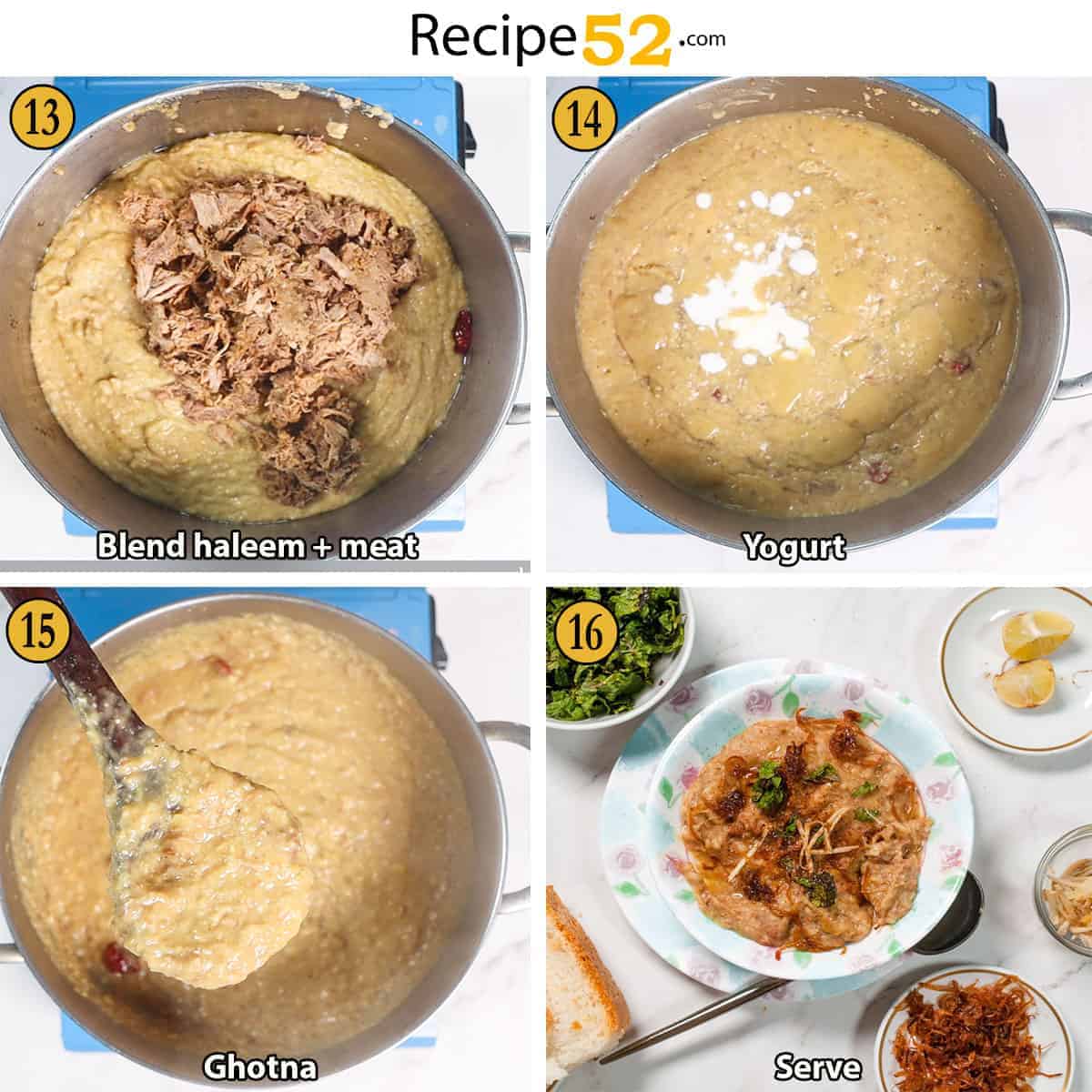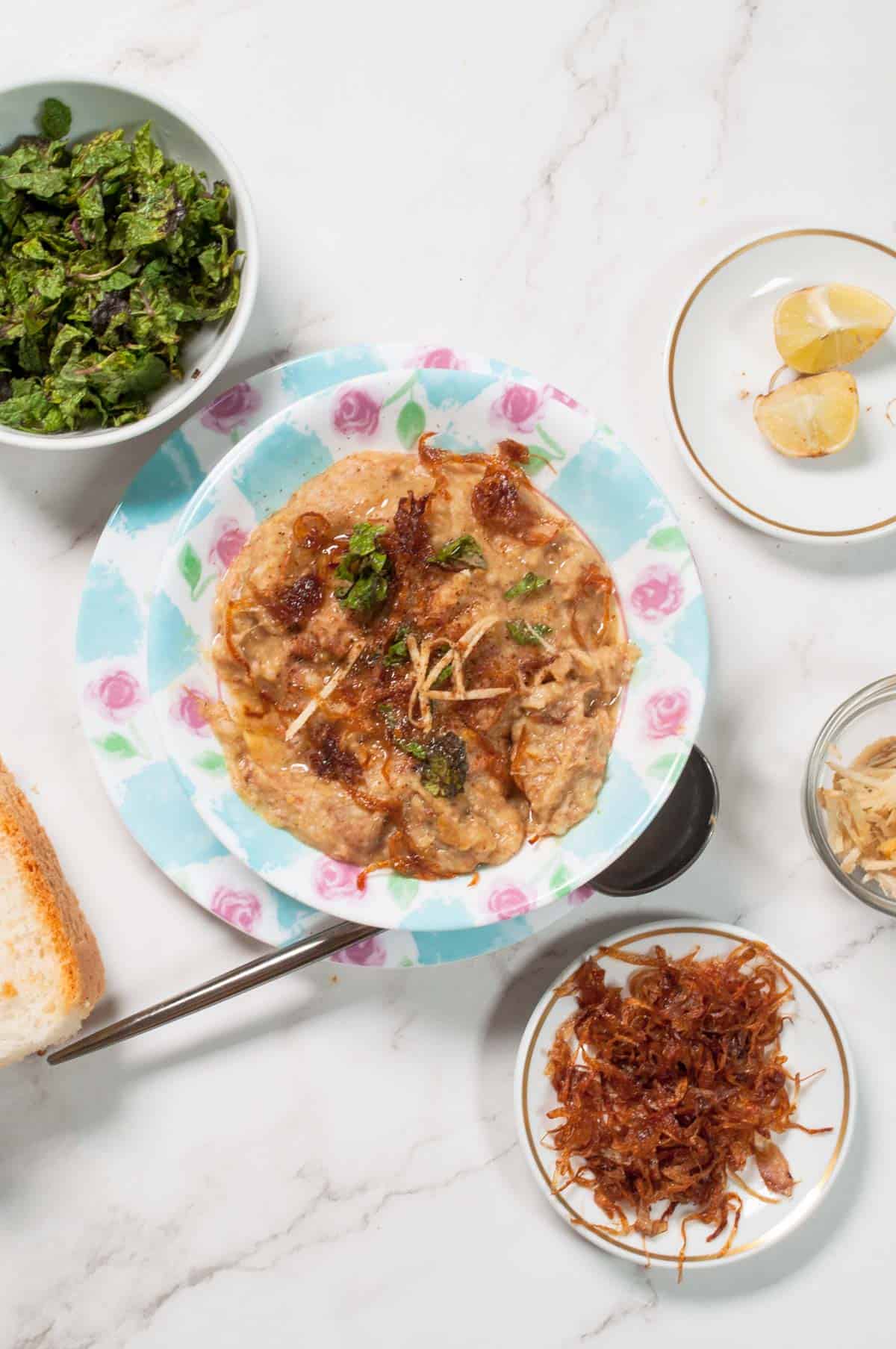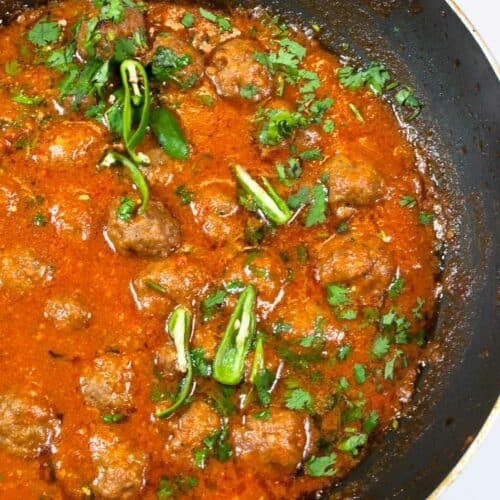I'm craving a warm bowl of beef haleem with crispy fried onions, lemon, and chaat masala. I can imagine you are too! Let's make this simplified haleem recipe at home with my tried-and-tested recipe.

Although Pakistni haleem recipe is a complete meal and a charm on any occasion, it is fervently made in the holy month’s Ramadan and Moharram.
Haleem is a spicy and hearty stew made with meat, wheat, haleem masala and lentils. It has a slightly sticky texture and threads of pounded meat.
This is a generous dish that is almost always made in large quantities and shared with guests or sent to neighbors, friends, and family.
Haleem originated from harissa, a North African stew that was traditionally eaten by Arab tribes while traveling. The Middle Eastern version of haleem is mild in spices and does not contain lentils.
It came to India in the Mughal kitchen during the time of Babur. The traditional Hyderabadi haleem, a spicier version more commonly served in India and Pakistan, has some lentils and barley added to it.
Technically, it is khichda, a type of beef haleem that has a mix of grains, lentils, meat, and spices.

Why This Recipe Works?
- Beef Haleem is traditional dish with rich in history it has been enjoyed for centuries by people from all over the world. It is a popular dish in many cultures, including Middle Eastern, Indian, and Pakistani cultures.
- This dish is cooked in large pot with large quantities so its great for large gatherings. It is one of the favorites alongside biryani and karahi gosht.
Ingredients
Let's look at the ingredients to make this luscious and satisfying beef haleem. The first image displays the grains and lentils that will be used for making the haleem base.

- Wheat: Authentically whole wheat kernel (gehoon) without the skin is used for Haleem recipe. But some recipes call for broken wheat which reduces the cooking time and process.
- Barley: It is optional and can be substituted with more wheat. Barley (jau) grains help to give the sticky texture to Haleem so I highly recommend adding it.
- Lentils and rice: Bengal gram (Chana dal) gives the best taste to the Haleem and I have also use a number of lentils like yellow (moong), red (masoor), for increased nutritional value.
This second picture shows the necessary ingredients to cook the juicy and flavorful meat.

- Meat: Perfect meat to use for haleem is beef shank as this meat cut gives those thread of meat in the final dish. Haleem traditionally is made with red meat in the form of beef, lamb, and mutton. Sometimes, camel meat is also used. Now chicken Haleem recipe is also gaining popularity.
- Bones: Bones have flavor, fat and nutrients that enhance Haleem flavor greatly. So it is essential to add either bones or bone broth in haleem for authentic taste.
- Haleem Spice Mix: You can get ready-made Haleem spice mix which is an easy way to do it. Or here is my haleem spice mix recipe with simple Indian spices.
- Other ingredients: Some other fresh spices like ginger, garlic, chillies and herbs are also added.
- Condiments: Condiments like fried onion, lemon wedges, mint, coriander, ginger slices, chilli slices and chat masala is a must for Beef Haleem and makes it super tempting. You just can’t have enough.
How To Make It?
Let Begin! There are 3 major steps of haleem recipe.
- Cook grains and lentils until soft and mushy. Then blend it with an immersion blender.
- The second step is to cook meat and shreds it in a processor.
- The third is to mix wheat and meat curry and finish it with tempering. That's it. Although a long process but not difficult.

- Begin by washing wheat and barley until water runs clear. Then soak it for 4 hours at least or preferably overnight.
- Similarly, combine lentil and rice in other pots and wash thoroughly. Lentils require just 2 hours of soaking.
- Discard the water of soaked wheat and lentils. Transfer to a pot. Add ginger, garlic, and chili paste. Fill the pot with water until the water level reaches 2 inches above the grains and lentils. (You can always add more water if needed.) Bring water to boil then reduce heat to medium-low. Cover and cook for 60-90 minutes on medium heat until wheat kernels are soft and mushy.
- Set aside the cooked wheat and lentil mixture for later.

- In another pot fry thinly sliced onions until golden.
- Now add meat, bones and haleem spice mix to it. Mix well and stir fry on high heat for 2-3 minutes.
- When the color of meat changes, fill the pot with water just enough to barely cover the meat. Bring the meat to boil, then cover the pot and cook for 30-45 minutes until tender. Meat curry is ready, let it cool.

- Remove meat (and bones, if using) from the curry with a slotted spoon. Add the gravy to the grains and lentil and blend it with an immersion blender. ( Add cold water if the mixture is too thick to avoid too much strain on the machine.)
- Separate meat from the bones.
- Shred the meat in the food processor in batches.(Alternately, you can also pound the meat to shred it.) Add the shredded meat in the haleem.
- In a pan heat oil and fry garlic until lightly golden. Then add the ingredients of tempering and fry for one minute.

- Now, add blend the blended lentil mixture and shredded beef to the tempering.
- Then add the yogurt. Mix well and adjust consistency by adding water if needed. (The haleem shpuld have porridge like consistency.)
- The last step is to stir haleem with a ghotna or a sturdy wooden spatula in a circular motion for 5-10 minutes (at intervals) to develop a sticky consistency.
- Haleem is ready to serve. Fill a large bowl with hot haleem. Garnish with fried onions, mint, and ginger slices.
Expert Tips
- Soak wheat overnight: Wheat kernel needs 4-6 hours of soaking so soaking overnight works best. (Some people soak wheat 1 day ahead and cook wheat overnight on slow heat.)
- Soak Lentils too: Lentils require 2 hours of soaking. If in hurry soak in warm water for 30 minutes.
- Cook wheat and lentil until mushy: This is important regardless of the cooking time make sure the grains are super soft before you blend it. This will give the haleem a homogenised texture.
- Meat: You can use any red meat for this recipe but beef shank works best. If you use boneless meat then add large bones of beef also to it. Remove bones before shredding meat. Alternatively, you can use bone broth instead of extra bones.
- Leftover haleem tastes amazing. I also make paratha from leftover haleem which is melt in the mouth delicious. I make it the same way as I make Leftover Daal Paratha here.
- Haleem freezes well and is great for canning as well. You can easily refrigerate it for 1 to 2 days in an airtight container or freeze it for 2 to 3 months in a freezer. Simply thaw, heat, and enjoy!

FAQ
You can easily find grains and lentils in Indian stores and super markets.
Thick porridge-like mild Haleem can be eaten alone or with Kadhi and is very filling. The spicy Hyderabadi Haleem is usually paired with naan or Karak double roti. Bharta salad pairs well with Haleem. Indian Lemonade or lemo pani is good drink to finish the course and quench the heat of spices.
It is a multi stepped dish which takes some planning, long cooking time and specific Ingredients. Apart from it, it doesn't require special culinary skills or weeks of practise so it is on medium difficulty level in my opinion.
To garnish simply sprinkle some chaat masala (if using), fried onions, mint, ginger, and green peppers on top. You can also add a squeeze of fresh lemon juice for a tangy kick.
Hungry for more, check these!
If you try this Haleem recipe, I'd LOVE to hear your feedback in the comments. Your 5-ratings motivate me to do my best. Stay connected for more recipes and videos on Facebook, Instagram, Pinterest, and Youtube.
📖 Recipe

Haleem Recipe
Ingredients
For grains and lentils
- ¾ cup whole wheat kernels, (gehoon)
- ¼ cup barley, or oats (jau)
- 2 tablespoons rice
- 2 tablespoons red lentil, (masoor dal)
- 2 tablespoons yellow lentil, (moong dal)
- ⅓ cup bengal gram, (chana dal)
- 1½ tablespoons green chilli
- 1 tablespoons ginger
- 1 tablespoons garlic paste
- ½ teaspoon salt
For meat curry
- 4 tablespoons oil
- 1 large onion
- 2½ tablespoons haleem masala
- ½ kg boneless beef, plus extra bones
- 2 cup water
Tempering
- 2 tablespoons oil, use oil used to fry sliced onions
- 1 tablespoon chopped ginger
- 1 tablespoon chopped garlic
- ½ teaspoon cumin seeds
- 4 round button chilles
For Garnish
- 3 medium onions, skip if using ready-made fried onions.
- ginger, sliced
- mint leaves
- chat masala
- green chillies, sliced, less spicy variety
Instructions
For wheat and lentils
- Take wheat and barley in a pot. Wash and soak for 4 hours at least or preferably overnight.
- Combine lentil and rice in another pot. Wash and soak for 2 hours.
- Take soaked lentils, wheat and barley in a large heavy bottomed pot. Add salt, ginger, garlic, green chilli paste and water. The level of water should be 2 inch above the grains.
- Bring it to a boil then reduce heat to slow, cover the lid tightly and cook for 60 minutes until wheat grains are soft and mushy. Keep stirring at intervals.
For Meat Curry
- In another pot fry thinly sliced onions until golden.
- Now add meat and haleem spice mix to it. Mix well and stir fry on high heat for 2-3 minutes until the color of meat changes. Then fill the pot with just enough to barely cover the meat.
- Bring it to boil, then cover the pot tightly and cook for 30-45 minutes until tender. Meat curry is ready, let it cool.
- Remove meat (and bones, if using) from the curry with a slotted spoon, set aside.
- Add the remaining gravy to the grains and lentil and blend it with an immersion blender. ( Add cold water if the mixture is too thick to avoid too much strain on the machine.) Set aside.
- Shred the meat in the food processor in batches. (Discard the bones, if used.) Set aside.
For Tempering
- In the meat pot heat oil and fry garlic until lightly golden. Then all the ingredients of tempering and fry for one minute.
- Add the blended grain and lentil, shredded meat and yogurt in the tempering and mix well. Continue to cook on slow heat.
Ghotna
- If the haleem is thick add water and adjust consistency. Stir with a ghotna or a sturdy wooden spatula in a circular motion for 5-10 minutes with intervals for sticky and homogenised texture.
- Do a taste test and adjust salt. Adjust heat if needed by adding more haleem spice mix.
For Garnish
- Fry sliced onion in pan until golden. Work in two batches. Spread onions on kitchen towel so it gets crispy.( Skip this step if using store brought fried onions.)
Serve Haleem
- Fill a large bowl with hot haleem. Garnish with fried onions, mint, and ginger slices.
- This step is optional. Heat 2-3 tablespoon of oil until smoking hot and drizzle over the bowl of haleem. Serve with lemon wedges and a place of condiment on the side.










Ambreen Pervez says
Tried this recepe today, Mariam and it turned out lip smacking 'perfect!' comments
Mariam Sodawater says
Hi Ambreen, I'm so glad you liked it. Thanks for leaving feedback. It is so motivating.
Mehboob says
I was making a Gujarati daal dhokli and happened to overboil the dhoklis (kneaded wheat flour mixed with a little gram flour, rolled into rotis and cut into bite size squares). That's when i got this notion of Reverse Engineered Khichda. Instead of going to all the trouble of soaking wheat overnight, boiling it to the right consistency and blending one can simply boil these dhoklis till they are well cooked and then mash them up with a wooden pounder along with the boiled barley and meat. I have found the texture is much smoother. Rest as per your detailed instructions, needless to say. Do try it out.
Mariam Sodawater says
Thanks for the suggestion, it sounds very easy and interesting. I must try. You are very creative Mehboob.